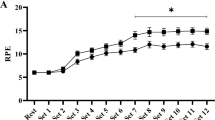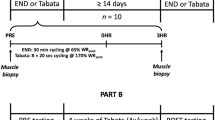Abstract
To evaluate low-intensity exercise training induced changes in the expression of dihydropyridine (DHP) and ryanodine (Ry) receptors both mRNA and protein levels were determined by quantitative RT-PCR and immunoblot analysis from gastrocnemius (GAS) and rectus femoris (RF) muscles of mice subjected to a 15-week aerobic exercise program. The level of muscular work was assayed by changes in myosin heavy chain (MHC) content, myoglobin (Mb) expression and muscle size. The mRNA expression and optical density of DHP receptor increased significantly in GAS by 66.8 and 39.5%, respectively. The expression of Ry receptor, on the other hand, was not up-regulated. In RF, there was a significant increase of 38.4% in the mRNA expression of DHP receptor, although the protein level remained the same. No changes in Ry receptor expression was observed. The training resulted in a 1.58% increase in the amount of MHC IIa and a 2.34% decrease in that of IIb and IId in GAS. A significant 8.3% increase in the Mb content was observed. In RF, no significant changes in MHC or in Mb content were noted. Our results show that an evident increase in the mRNA and protein expression of DHP receptor was induced in GAS even by a relatively low-intensity exercise. Surprisingly, contrast to DHP receptor expression, no changes in Ry receptor mRNA, or protein levels were found, indicating more abundant demand for DHP receptor after increased muscle activity.
Resumen
Para evaluar los cambios inducidos en la expresión de los receptores de dihidropiridina (DHPR) y rianodina (RyR) por el entrenamiento con ejercicio de baja intensidad, se determinan los niveles de mRNA y de proteína mediante el análisis de RT-PCR cuantitativa e inmunoblot de los músculos gastrocnemius (GAS) y rectus femoris (RF) de ratón sometido a un programa de ejercicio aeróbico durante 15 semanas. El nivel de trabajo muscular fue determinado por los cambios en contenido de cadena pesada de miosina (MHC), expresión de mioglobina (Mb) y tamaño del músculo. La cantidad de mRNA y de proteína de DHPR aumentó significativamente en un 66,8 y 39,5% respectivamente. La expresión de RyR, por otro lado, no se vio incrementada. En RF hubo un aumento significativo del 22,7% en la expresión del mRNA de DHPR, aunque los niveles de proteína permanecieron inalterados. Tampoco se observaron cambios en la expresión de RyR en RF. El entrenamiento dio lugar a un aumento del 1,58% en la cantidad de MHC IIa y disminución del 2,34% en MHC IIb y IId en GAS, con incremento significativo del 8,3% en el contenido de Mb. En RF no se detectaron cambios significativos en el contenido en MHC ni en Mb. Nuestros resultados muestran que se induce un evidente aumento en el nivel de RNAm y de proteína DHPR en GAS mediante un ejercicio de relativamente baja intensidad. Sorprendentemente, en contraste con la expresión de DHPR, no se encontraron cambios en los niveles de mRNA ni de proteína de RyR, indicando mayor demanda de DHPR al incrementar la actividad muscular.
Similar content being viewed by others
References
Allen, D. L., Harrison, B. C., Maass, A., Bell, M. L., Byrnes, W. C. and Leinwand, L. A. (2001):J. Appl. Physiol.,90, 1900–1908.
Ariano, M. A., Armstrong, R. B. and Edgerton, V. R. (1973):J. Histochem. Cytochem.,21, 51–55.
Bradford, M. (1976):Anal. Biochem.,72, 248–254.
Close, R. I. (1972):Physiol. Rev.,52, 129–197.
Cognard, C., Rivet-Bastide, M., Constantin, B. and Raymond, G. (1992):Pflügers Arch.,422, 207–209.
Demirel, H. A., Powers, S. K., Naito, H., Hughes, M. and Coombes, J. S. (1999):J. Appl. Physiol.,86, 1002–1008.
Dudley, G. A., Abraham, W. M. and Terjung, R. L. (1982):J. Appl. Physiol.,53, 844–850.
Fill, M. and Copello, J. A. (2002):Physiol. Rev.,82, 893–922.
Froemming, G. R., Murray, B. E., Harmon, S., Pette, D. and Ohlendieck, K. (2000):Biochim. Biophys. Acta,1466, 151–168.
Goldspink, G. (1977): In Mechanics & Energetics of Animal Locomotion”. (Alexander RMcN, Goldspink G. eds.) Chapman and Hall, London, pp. 1–22.
Ingjer, F. (1979):Eur. J. Appl. Physiol.,40, 197–209.
Jorgensen, A. O., Shen, A. C., Arnold, W., Leung, A. T. and Campbell, K. P. (1989):J. Cell Biol.,109, 135–147.
Kandarian, S., O’Brien, S., Thomas, K., Schulte, L. and Navarro, J. (1992):J. Appl. Physiol.,72, 2510–2514.
Laemmli, U. K. (1970):Nature,227, 680–685.
Laughlin, M. H., Armstrong, R. B. (1982):Am. J. Physiol.,243, H296-H306.
Leong, P. and McLennan, D. (1998):J. Biol. Chem.,273, 7791–7794.
Lynch, G. S. and Williams, D. A. (1994):Acta Physiol. Scand.,150, 141–150.
Majalahti-Palviainen, T., Hirvinen, M., Tervonen, V., Ilves, M., Ruskoaho, H. and Vuolteenaho, O. (2000):Endocrinology,141, 731–740.
Mattson, J. P., Miller, T. A., Poole, D. C. and Delp, M. D. (2002):J. Histochem. Cytochem.,50, 1685–1692.
Mänttäri, S., Pyörnilä, A., Harjula, R. and Järvilehto, M. (2001):J. Muscle Res. Cell Mot.,22, 61–67.
Mänttäri, S. and Järvilehto, M. (2005):BMC Physiol. 5.
Ørtenblad, N., Lunde, P. K., Levin, K., Andersen, J. L. and Pedersen, P. K. (2000):Am. J. Physiol.,279, R152-R160.
Pansarasa, O., D’Antona, G., Gualea, M. R., Marzani, B., Pellegrino, M. A. and Marzatico, F. (2002):Eur. J. Appl. Physiol.,87, 550–555.
Péréon, Y., Navarro, J., Hamilton, M., Booth, F. W. and Palade, P. (1997):Biochem. Biophys. Res. Commun.,235, 217–222.
Pette, D. and Staron, R. S. (2001):Histochem. Cell Biol.,115, 359–372.
Roneus, M., Essen-Gustavsson, B., Lindholm, A. and Persson, S. G. (1992):Equine Vet. J.,24, 292–294.
Saborido, A., Molano, F., Moro, G. and Megías, A. (1995):Pflügers Arch.,429, 364–369.
Schneider, M. and Chandler, W. (1973):Nature,242, 244–246.
Serrano, A. L., Quiroz-Rothe, R. and Rivero, J. L. (2000):Pflügers Arch.,441, 263–274.
Towbin, H., Staehelin, T. and Gordon, J. (1979):Proc. Natl. Acad. Sci. USA,76, 4350–4354.
Author information
Authors and Affiliations
Corresponding author
Rights and permissions
About this article
Cite this article
Mänttäri, S., Anttila, K., Kaakinen, M. et al. Effects of low-intensity training on dihydropyridine and ryanodine receptor content in skeletal muscle of mouse. J. Physiol. Biochem. 62, 293–301 (2006). https://doi.org/10.1007/BF03165758
Received:
Issue Date:
DOI: https://doi.org/10.1007/BF03165758




